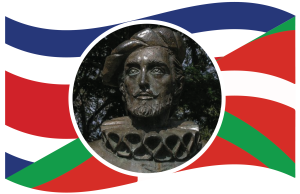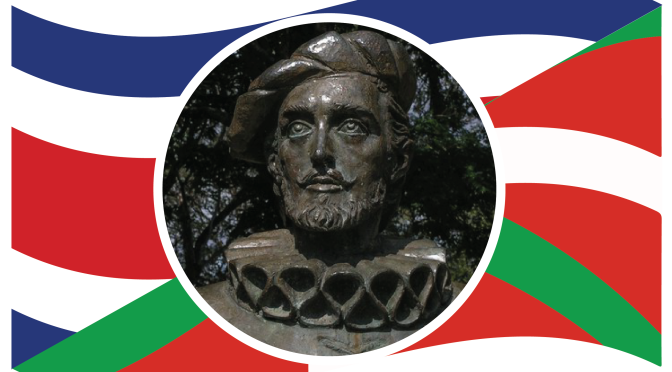At the end of June, my wife, my daughter, and I did an ecotour of Costa Rica. We did and saw lots of awesome things, from wildlife (the goal was to find frogs and we saw a lot of them, as well as bats, tapir, monkeys, and crocodiles), whitewater rafting, ziplining, waterfalls, cocoa and coffee tours… it was jam packed. But one thing we didn’t see a lot of was Basque names. We see them everywhere in New Mexico, but not so much in Costa Rica. It made me curious about the Basque history of this beautiful country…

- While what would become Costa Rica was first encountered by Christopher Columbus in 1502, and many settlers tried to colonize the region in the name of the Spanish crown in later years, it wasn’t until 1573 that Costa Rica was established as its own province – the Province of Costa Rica – separate from that of other larger entities such as the Kingdom of Guatemala, replacing the Province of Nuevo Cartago y Costa Rica. In that year, Diego de Artieda Chirino y Uclés was authorized by King Felipe II to “discover and settle the province called Costa Rica.” Artieda was from Esparza de Salazar (Espartza Zaraitzu in Euskara), a small town in Nafarroa. His parents were Pedro de Uclés and María Enriquez Chirino. He was charged with founding at least three cities, one of which – Artieda del Nuevo Reino de Navarra – didn’t last long. He also founded the city of Esparza (today Esparta) in 1578. In 1577 he was named governor for life of Costa Rica, until he was deposed in 1589. He died a year later in Guatemala City.
- Two Basque families figured prominently in the early history of Costa Rica. The first is the Retes family. Jerónimo de Retes Salazar was born in 1560 in Bilbao to Pedro de Retes and Doña Petronila Lloredo. He married María de Ortega in 1595 and died young, in 1596, in Cartago, Costa Rica. His son, Jerónimo de Retes y López de Ortega, was an important military man and explorer of the region. He was captain of the militia and later Alguacil Mayor of Cartago. He subdued two kings of the indigenous Votos, Pocica and Pisiaca, and explored the Cutrís and Jovi rivers (today San Carlos and Sarapiquí). He was a very active merchant and continued to make excursions into indigenous areas, trying to capture slave labor. His daughter, Doña Ana de Retes, sold some of the land she inherited from her father which later became the site of the city of Santa Ana.
- The second family was the Echavarría Navarro. Juan de Echavarría Navarro was born in sometime in the late 1580s in Spain. He became treasurer of Costa Rica until 1632 when he died at a relatively young age. He had married María de Sandoval. Their son, also named Juan, married the previously-mentioned Doña Ana de Retes. Juan, the junior, was mayor of Cartago for a few years. He obtained weapons and ammunition to protect the city and region against pirates. Two of his brothers, Domingo and Francisco, became priests.
- By the 18th century, the economic fortunes of these families had declined. However, connections to the Basque Country remained strong. The women descended from these “first” families often married emigrants from the Basque Country, men like Domingo Inza and Lorenzo de Arburola Irribaren from Gipuzkoa, Luis Fernando de Liendo y Goicoechea from Bizkaia, and Esteban de Hoses from Nafarroa. Thus, through these networks with the Basque Country, Basques continued to be an important part of Costa Rican society and politics.
- However, the cultural impact of the Basque immigrants to the region is less visible. There was a fronton in San José, the capital. Beti-Jai opened in 1904. This fronton is now the headquarters of the Technological Institute of Costa Rica stands .A second, named Jai-Alai, opened in 1929. This second one was built by two Basque brothers – Ángel and Serafín Makúa. Serafín, an architect, also was involved in the construction of frontons Havana, Mexico City, San Salvador, and Guatemala City. However, Jai-Alai lasted only a decade before it was converted to a skating rink and then a police station, before being demolished to make way for an artist market. The club Campestre Español, in Belén, opened a fronton in 2002.
Primary source: Quirós Vargas, C., Velázquez Bonilla, C., & Payne Iglesias, E. (2004). Los Vascos en la República de Costa Rica. Análisis de su posición social, económica y mentalidad colectiva. Siglos XVII y XVIII. Revista Del Archivo Nacional, 68, 117-139.



Thank you for your interesting post about Costa Rica. I am doing family research, came across your newsletter and was surprised to read in your introduction that you didn’t find many Basque surnames in CR. Pura Vida! ~SMC
Hi Sonia, I just meant that I didn’t run into many when I was there, not as many as maybe I thought I would. But there were certainly some and I’m sure there are many more that I just didn’t find. 🙂